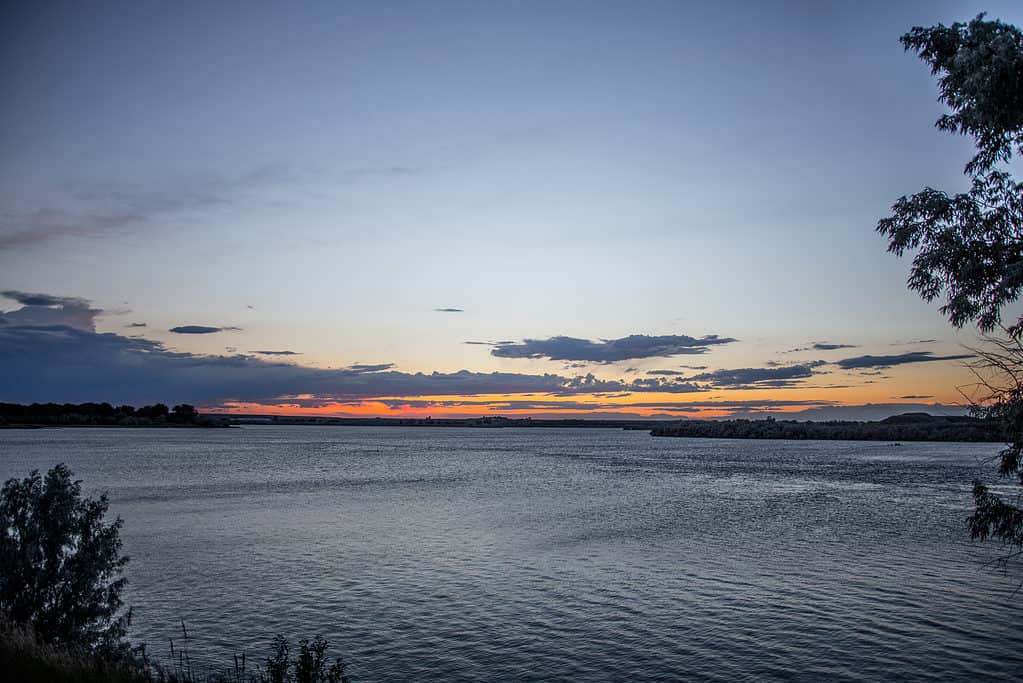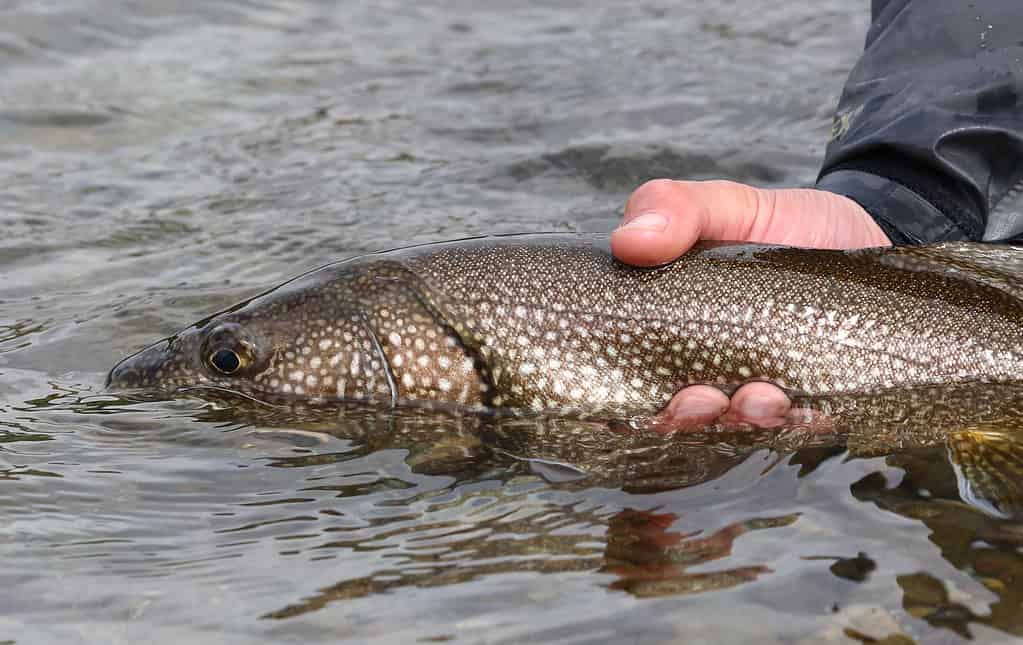Welcome to Fort Peck Lake, a captivating destination brimming with opportunities for fishing and exploration. Located in the eastern prairie region, this vast reservoir stretches over an impressive 245,000 acres. It is the largest lake in the state of Montana.
Fort Peck Lake serves as a crucial source of water and hydroelectric power. It entices visitors with its unparalleled fishing prospects, breathtaking scenery, and fascinating history. Plus, in Jurassic Park III, the lake is a location where excavation takes place! Let’s discover the allure of Fort Peck Lake and embark on an unforgettable adventure in the great outdoors.
Location

Fort Peck Lake is a true gem of American engineering and natural beauty, extending over 134 miles of central Montana.
©Beets Productions/Shutterstock.com
Nestled within Montana’s secluded wilderness, Fort Peck Lake is a considerable distance from major towns. Glasgow, the nearest urban center, and the quaint town of Fort Peck are both in proximity to the lake. The shoreline of the lake stretches far beyond the dam, encompassing vast tracts of untouched nature.
It is crucial to possess an all-terrain vehicle when venturing into the Fort Peck region. This is particularly true during wet seasons when the pathways become slippery and challenging for regular cars to travel. Since the closest major town is over 50 miles away, finding oneself stranded in this region could be troublesome.
Fort Peck Marina, situated on the dam’s western side, offers direct access to the lake. While multiple routes approach the area from various directions, some are dirt roads and not suitable during specific weather conditions.
The Charles M. Russell National Wildlife Refuge surrounds the entire lake area, encompassing more than a million acres of land. The serene remoteness of Fort Peck Lake entices numerous visitors. The region has many back roads that enable adventurers to experience some of Montana’s most isolated areas.
History
In the 1940s, Mother Nature unleashed her wrath upon the Missouri River, leaving in her wake destruction and despair. The floods caused economic turmoil and threatened the production of vital military supplies during World War II.
In a daring move, the federal government launched the Pick-Sloan Plan. This was a grandiose undertaking involving the construction of numerous dams and reservoirs along Missouri and its tributaries. One of the most impressive feats of engineering was the Fort Peck Dam, crafted by the U.S. Army Corps of Engineers over a grueling seven-year period.
In 1947, the massive reservoir finally reached its full capacity, but not before the government forced ranchers and farmers living in the valley bottom to relocate.
Despite the high cost, the project was a tremendous success. The dam safeguarded the region from future floods and started an era of economic growth. Today, the Fort Peck Dam remains an iconic testament to resilience and human innovation against the unpredictable forces of nature.
Size
Fort Peck Lake is a true gem of American engineering and natural beauty. This incredible man-made lake extends over 134 miles of central Montana. It boasts a mind-boggling 18,700,000 acre-feet of water at full capacity!
But it’s not just the lake’s size that impresses. Fort Peck’s shoreline is studded with inlets and twists, making it a fascinating and thrilling destination for outdoor enthusiasts. Its catchment area includes the mighty Missouri River, as well as tributaries such as Fourchette Creek, Musselshell River, Hell Creek, and Timber Creek. It also incudes the aptly-named Dry Creek, which is the longest sidearm of the reservoir at 30 miles in length.
At 245,000 acres, Fort Peck is Montana’s largest lake by surface area. It is surrounded almost entirely by the 1,719-square-mile Charles M. Russell National Wildlife Refuge. This protected area has done an incredible job preserving the surrounding high prairie and hill country, making Fort Peck a true natural wonderland.
Depth
At an average depth of 76.3 feet, this man-made wonder offers a fascinating aquatic world to explore.
For the truly adventurous, Fort Peck’s average maximum depth of 220 feet offers a world seldom seen by human eyes. The depths of this lake hide unique species and formations.
Water Level
Boasting a normal operating pool elevation of 2,246 feet above mean sea level and a maximum operating pool elevation of 2,250 feet above mean sea level, Fort Peck Lake is a true marvel of human engineering.
Below are some historical water levels for Fort Peck Lake:
| Historic Crests | Water Level |
|---|---|
| 06/17/2011 | 2,252.20 ft |
| 07/14/1975 | 2,251.60 ft |
| 07/23/1997 | 2,250.31 ft |
| 06/20/1978 | 2,249.60 ft |
| 07/12/1976 | 2,249.00 ft |
| Low Water Records | Water Level |
|---|---|
| 01/25/1956 | 2,167.40 ft |
| 02/28/2007 | 2,196.30 ft |
| 01/31/2005 | 2,198.30 ft |
Fishing

The lake trout can be found in depths of 15 to 125 feet. Browns and rainbows are generally caught in the river below the dam.
©Iryna Harry/Shutterstock.com
Fort Peck Lake is a true gem for anglers. It boasts more miles of shoreline than the California coast and an incredible 50 species of fish! The region is crisscrossed by Yellowstone and the mighty Missouri rivers, offering endless opportunities for fishing enthusiasts.
It’s not just the variety of fish that makes Fort Peck Lake so special – it’s their size and abundance. Some of the lake’s biggest catches weigh over 100 pounds! This is a true treasure paradise for anglers looking for a challenge.
Fort Peck is thought to be the best walleye lake in Montana. It’s not uncommon to find 30-inch walleye in these waters.
For those looking to catch trout, Fort Peck has you covered. The lake is home to some of the best trout, such as brown trout, rainbow trout, and lake trout. The lake trout can be found in depths of 15 to 125 feet. Browns and rainbows are generally caught in the river below the dam.
Fort Peck is the only lake in Montana where you can harvest king salmon ranging from 16 to 30 pounds. Northern pike are also abundant and very large, averaging between 30 and 40 inches. Smallmouth bass has also become a popular catch here, with fish ranging from three to five pounds on average.
Fort Peck also offers some of the best ice fishing opportunities in North America.
Every day, anglers reel in trophy fish, making this lake a true mecca for fishing enthusiasts.
Geology
Primarily located within Valley County, Fort Peck Lake was established during the 1930s as a component of the Missouri River Basin project. The region’s geology is predominantly characterized by the underlying Fort Union Formation, comprising sandstone, siltstone, and shale. This formation was deposited approximately 65 million years ago during the Paleocene epoch. As a result, it is renowned for its fossil remnants of early mammals.
The area surrounding the lake also boasts an array of geological features, such as glacial deposits and sedimentary rock formations. The lake’s valley was shaped by glacial meltwater during the Pleistocene epoch.
The geology of Fort Peck Lake represents a captivating fusion of ancient formations and more recent glacial influences. Because of these facotrs, it is a remarkable and appealing destination for those intrigued by the region’s natural history.
Boating
Navigating the waters of Fort Peck Lake is a favored pastime among both residents and visitors. With countless opportunities to relish the aquatic surroundings and breathtaking vistas, boating enthusiasts are never disappointed.
Numerous boat ramps are strategically positioned around the lake, enabling boaters to easily access the water. Additionally, Fort Peck Marina and Hell Creek Marina provide comprehensive services, including fuel, boat storage, and other amenities. For those without their own vessel, boat rentals are available at Hell Creek Marina. Several other locations near the lake also offer convenient access points for various recreational pursuits.
From fishing and water skiing to leisurely cruises, there is no shortage of activities to enjoy on Fort Peck Lake. The pristine, tranquil waters are ideal for water skiing, wakeboarding, and tubing.
Embarking on a boating adventure at Fort Peck Lake is an extraordinary way to immerse yourself in the rugged splendor of Montana’s wilderness. Whether your interests lie in fishing, water skiing, or unwinding on the water, this captivating lake has something to offer everyone.
Camping
Fort Peck Lake features two primary campgrounds. Nestled among cottonwoods in a grassy expanse, the Downstream Campground boasts 86 family campsites. This includes 71 with electrical hookups and 15 exclusively for tents. A spacious group campsite with reservable picnic shelters and electrical hookups is also available. Amenities include playgrounds, a basketball court, showers, horseshoe pits, a dump station, and flush and vault toilets. It also has a fish cleaning station, ideal for anglers visiting the lake’s three ponds.
On the lake’s northern shore, the West End Tent and Trailer Campground has 13 peaceful sites with electrical hookups. Perched atop a hill, this campground affords visitors spectacular lake views and serves as an excellent location for fishing aficionados. Each site features a fire ring and picnic table, while guests have access to water supplies, showers, and flush and vault toilets. The nearest dump station is approximately five miles away at the Downstream Campground. As wildlife frequent the area, pet owners should be vigilant.
Both campgrounds provide distinct experiences and outstanding opportunities to appreciate the natural beauty of Fort Peck Lake. Regardless of whether you prefer a bustling environment or a calm retreat, you’ll find a suitable option here.
Hiking

The Beaver Creek Nature Trail is a three-mile paved path meandering through the natural habitat, offering a peaceful stroll.
©adriaticfoto/Shutterstock.com
The picturesque surroundings of Fort Peck Lake provide a sublime setting for hiking enthusiasts. Visitors can traverse remote and extensive landscapes. The wide-open scenery along the lake’s edges adds a captivating element to any trek.
A favorite among those seeking a relaxed hike is the Beaver Creek Nature Trail. This three-mile paved path meanders through the nearby campground, offering a peaceful stroll through the natural habitat. It has views of the Missouri River and adjacent wooded areas. The trail is also an excellent location for bird watching and observing wildlife. It is best during the fall, summer, and spring months.
Situated along the Hell Creek Arm of the lake, the Hell Creek Trail presents visitors with a light, easy path. This just-over-half-mile trail is an out-and-back route suitable for all experience levels. This trail is primarily used for nature observation, wildlife viewing, bird watching, and walking. Hell Creek Trail also acts as a starting point for boat camping in the nearby wild and picturesque Missouri Breaks.
Hunting
Fort Peck Lake and the surrounding region offer a prime setting for hunting enthusiasts of all kinds. This area is a haven for hunters, featuring a wide range of species to choose from, such as elk, antelope, sharp-tail grouse, pheasants, sage hens, and Hungarian partridge.
The lake is also renowned for its waterfowl hunting, which many regard as the country’s finest. Adjacent to crops like peas, beans, lentils, corn, and wheat, the lake serves as an ideal habitat for waterfowl. Access to hunting locations is effortless, with miles of rivers and vast expanses of fields, ensuring hunters have ample space to set up their decoys.
Predator hunters will also find the area accommodating, as there is a significant population of coyotes that respond well to calls. Prairie dog hunting is another popular activity in the region. With such diversity and potential, Fort Peck Lake and its nearby areas represent a dream destination for any passionate hunter.
The photo featured at the top of this post is © iStock.com/bobloblaw
Thank you for reading! Have some feedback for us? Contact the AZ Animals editorial team.







